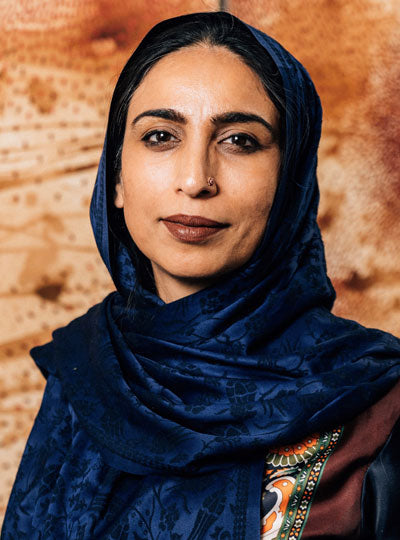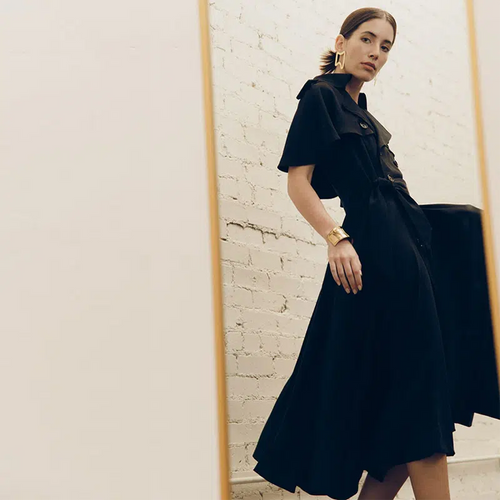 Namaloom (Untitled #4), 2020, text and 24-karat gold on
Namaloom (Untitled #4), 2020, text and 24-karat gold ontea-stained paper, 30 x 20 inches
For nationally renowned Pakistani-American artist Ambreen Butt, the complexities of a broken world are not to be forgotten — they are to be examined in an evocative way that encourages thoughtful reflection. This notion is expressed in all of her work, which fuses the classical techniques of musawwiri (miniature painting) with contemporary Western art forms.
Eve & Max’s newest collection, Namaloom (meaning “unknown” in Urdu), features a print of black text with paint markings, and 24-karat gold leaf on tea-stained paper from Ambreen’s 2017-2020 Say My Name series. It explores striking contrasts between despair and hope, darkness and splendor. As Eve & Max debuts Namaloom with a permanent residency at the Grange Hall boutique in Dallas, we chat with Ambreen about the deeper undertones of her paintings, how she views the world and why she loves the detailed processes her work requires.
How did your upbringing in Pakistan influence your perceptions and inform the contrast of broken and beautiful, which is integral to your work?
The artist in me was inspired by the Pakistani culture, which is full of color and emotions. Even walking on the street, you see the way a street hawker decorates a fruit cart. It's done in such a beautiful way. What I've been doing for the past couple of decades is a combination of classical techniques with techniques of my own through my contemporary Western art training. I address socio-political issues and use a lot of symbolism. There are events that happen around us today that are disturbing. My work deals with issues of death and violence, but I try to pick up the broken pieces of society and put them together to create something completely new and beautiful. That's my response to the world around me.
 Pakistani-American artist Ambreen Butt – photo credit John Carrithers
Pakistani-American artist Ambreen Butt – photo credit John Carrithers
What issues are you passionate about?
I see the world through the lens of a woman and a mother. My latest work, Lay Bare my Arms, was based on gun violence. With this idea that they're for our protection, arms could refer to guns, or the place where a child feels most protected, in the arms of the mother. I recently grew an iris, nurtured it for a long time. One day, I saw it pop open — it was the most beautiful flower with so many colors in it, and a very delicate shape. Towards the end of the day, it closed. That short-lived beauty struck me.
That's a powerful analogy.
Collateral damage, the killing of the innocent, is a term that we don't really pay attention to. I started collecting the names and ages of children who've died during conflict. I wrote them over and over again on a piece of paper. Then I would rip it, cut it or shred it, and glue it on another piece of paper with a tea stain to make abstract portraits.
And that work is part of your Say My Name series, which is featured in the Namaloom collection. It shares the reality of war and the horrors of these conflicts. But it also delivers a message of hope, light and positivity.
Yes. There have been so many people who were unknown. There's no identification. I thought, “What does the unknown mean?” Then came the pandemic when we were literally living in the unknown. So, I started making multiple paintings based on the unknown — black paper with black embossed text. I also used gold leaf, which represents the light of someone’s life. It’s something very meaningful for the Namaloom collection, which are pieces you wear and keep for a long time.
This collection is your first experience using art as fashion.
Clothing is something women hold very precious. I still have a few things my mom used to wear, and I love the stories that come with them. It's a powerful medium. Beauty and aesthetics are the most essential elements in my work.
And this is Eve & Max's first collaboration with a female artist.
It's a privilege to work with a woman who thinks alike. The amount of work women put in, their time and energy that is emotional, intellectual and physical, the labor invested, whether it's in our art or driving around our children ... a lot of it can go unacknowledged.
The labor-intensive practice of your art — why are drawn to it?
I see it as meditation. It's important for my sanity. People who like to run, they talk about it in a different way. It's not about running; it's about that state of mind, a quiet zone of reflection. My miniature painting requires a lot of labor. The way I take a smaller brush, dip it in paint, and make a mark that's almost invisible. This practice enables the opening of the mind.
It seems therapeutic for you.
My work starts either in the kitchen or the garden. I buy different kinds of tea, cook them in my studio, and maybe let them cool for several days because the color changes. I recently took a saffron color from marigolds, and I made vegetable and fruit dyes. I do a lot of laser cutting, etchings and lithographs. I stitch, sew, glue, stain, paint and draw. In my work, all of these things are present in one, so it's like I create my own language.
Speaking of creating, in November you released your first monogram, "What Comes to My Lips."
I’m very excited. The book has selections from my life’s work in it. I often use Sufi poetry in my work as titles. I did a series of paintings called I Must Utter What Comes to My Lips, from a 14th century poet from Punjab. It’s written in Punjabi, but it translates to, “I must utter what comes to my lips. Speaking the truth creates chaos. Telling a lie saves one scarce. I am afraid of both these. Afraid I am both here and there. I must utter what comes to my lips.”
What is your hope for how your work is perceived?
I don't hope for the world to change. I don't expect my work to change people's minds. All I hope is that it provides a moment for them to reflect. There's a lot of detail that forces them to stay there. We're in a time of flipping through images constantly and mindlessly, so my focus is bringing that moment where the viewer is connected with themselves. And when they leave, they'll take something with them to think about.
Based in Dallas, Texas, Ambreen Butt is represented by Gallery Wendi Norris in San Francisco. She received her BFA from the National College of Arts in Lahore, Pakistan, and MFA from the Massachusetts College of Art and Design in Boston. Butt has exhibited in solo exhibitions at institutions that include Dallas Contemporary, TX; Institute of Contemporary Art in Boston, MA; Museum of Fine Arts, Boston, MA; National Museum of Women in the Arts, Washington, DC; and Worchester Art Museum, Boston, MA, and her work is collected by public institutions such as the Institute of Contemporary Art, Boston; the Library of Congress, Washington DC; Minneapolis Institute of Art, MN; the Museum of Fine Arts, Houston, TX; to name a few.



Leave a comment